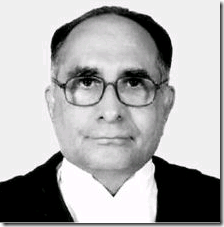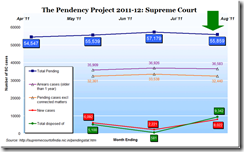
More than two thirds of cases pending in the Supreme Court – nearly 40,000 – were stuck not because of judges but due to procedural delays, including unpaid fees, unserved notice or documents not filed by counsel, according to detailed data released for the first time by the court as a result of its exercise in cataloguing court delays. [Download report]
Out of 56,383 cases pending in the Supreme Court, in 71 per cent (39,939 cases) “preliminaries were not completed”.
“Preliminaries” is set out as issues that are normally the preserve of lawyers such as “process fee not paid / notice yet not served / pleadings not completed, […] notice of lodgement of appeal not served / statement of case not filed, etc.”. However, a more detailed breakdown of those figures or an explanation of what each term included was not published, although a number of those “preliminaries” are understood to be within the direct control of lawyers.
The effect was particularly stark in 32,080 miscellaneous matters where 81 per cent of cases were “incomplete”, lacking such “preliminaries” and “not ready for hearing”. In the 24,303 regular hearing matters before the court only 57 per cent were incomplete and not ready for hearing.
The statistics reveal that on average completion of this “preliminaries” stage of the process took around two years (710 days) per case.
Only 16,444 of Supreme Court cases, or 29 per cent, were ready for hearing after all the preliminaries were completed.
Law Day pep talk, blame game?
Chief Justice of India (CJI) SH Kapadia in his speech for Saturday’s National Law Day on 26 November, when the figures were released, explained: “Before reading the statistical data, let me say that there is a need to highlight that all the stakeholders are accountable for maintaining and achieving standards of Court Excellence.
“The general tendency is to put the entire blame on the judges. The executive including the police and the bar have an important role to play in expeditious disposal of cases.”
“There is a backlog of cases, however, it is not as big as is sought to be projected. Please note that 74 per cent of the cases [23.4 million or 2.34 crore] are less than five years old,” said Kapadia. “The focus: expeditious disposal of 26 per cent of cases [8.50 million] which are more than five years old, i.e. ‘Five plus free’ should be the initiative.” 
The solution would be, said Kapadia, to appoint a “working committee on arrears and court management”.
Increasing workload: 3.9m added to mountain, subordinate courts plagued by service
Also published were the rates of disposal over the past two years: between May 2008 and April 2009, 61,850 cases were disposed in the apex court, while over the same period in 2010-11, the judges disposed of a total of 79,621.
In the first six months of this year so far from May 2011 to October 2011 the Supreme Court disposed of 32,420 cases, according to Legally India’s Pendency Project that documents pending cases at the highest court every month. Nevertheless the total number of pending cases at the Supreme Court increased by 1,836 over the last six months.
And across all courts, including high courts and subordinate courts, from 2005 to 2010 (31 December), 11.16 crore (110 million) cases were filed but only 10.77 crore cases were disposed of, revealed the new data.
This created a net deficit of 3.9 million cases over five years.
In subordinate courts 3.80 million cases alone were pending under section 138 - cheque bouncing-style offences - due to problems to do with service. The report suggested attaching police stations to courts to effect more efficient service.
Finally, the report also set out large increases this year in the courts’ budgets allocated by government, with the paperless “E court” initiative alone carrying a cost estimate of Rs 442 crore ($85m).
threads most popular
thread most upvoted
comment newest
first oldest
first
The reason we labelled it such is because lots of papers had reported the Law Day speech from three days before but no one actually went into the figures or did any analysis of these. Therefore our analysis and making sense of those figures was fairly exclusive.
Also, it ties into our Pendency Project - again, this is publicly available information but the analysis is exclusive to Legally India.
Best wishes,
Kian
threads most popular
thread most upvoted
comment newest
first oldest
first